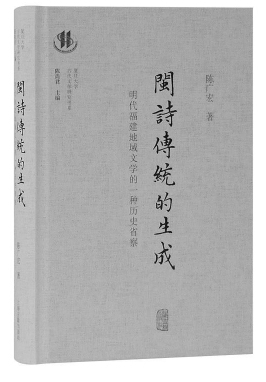A breakthrough in regional literature studies

The Formation of the Tradition of Min Poetry
Chen Guanghong, a professor from Fudan University, has long been dedicated to the studies of literature and documents in the Ming Dynasty. Since the late 1980s, he has paid attention to the literature in Fujian Province during the Ming Dynasty. His recent work The Formation of the Tradition of Min Poetry is a systemic summarization of his thought on the Fujian literature during the Ming Dynasty (the “Min” in the book title is the abbreviation for Fujian Province). This new book is also a notable achievement for studies of regional literature on the Chinese mainland.
Just as the title implies, the tradition of Min poetry refers to the poetic tradition in the regional literature of the Fujian area. This book aims to explore how literary scholars in the Fujian region in the Ming Dynasty established the poetic tradition of this region and why the desire for poetry became so strong in this age, as well as what it meant for the literature in this region and how it affected the poetic patterns and trends in the Ming and Qing dynasties.
The book contains a prologue and four chapters, following the formation, dissemination and canonization of the poetry of Yan Yu (c. 1192–1241). After this, the book explores the spread of the fashion of canonizing the poetic style of the Tang Dynasty during the Yuan and early Ming dynasties. The book then investigates the disintegration and reestablishment of the characteristics of Min poetry. At the end, the book discusses the establishment of the poetic tradition in the Fujian area. Chen presents to us the formation process of Min poetry, which canonizes the works of the “Ten masters in the Min area,” follows the poetic tradition of the Glorious Age of the Tang Dynasty, and highlights tonal patterns and rhyme schemes.
One of the major innovations of this book is the introduction of new methods from the studies of the history of books and publishing. This innovation is particularly notable in the first chapter, which investigates the dissemination of the poetry of Yan Yu during the transitional period between the Song and Yuan dynasties.
The first book that has included all the writings on poetics by Yan Yu was the Nepherite Grains of the Poets, edited by Wei Qingzhi in the Southern Song Dynasty. The fact that Yan’s poetry is so popular even today can be attributed to the editorial efforts of Wei. By investigating the methods and guiding principles which Wei applied and followed in editing and publishing the Nepherite Grains of the Poets, and by analyzing Yan’s poetry, Chen suggests that the structure of the writings of Yan Yu that we see today was substantially affected by Wei’s methods of editing and publishing.
(edited by CHEN ALONG)

 PRINT
PRINT CLOSE
CLOSE